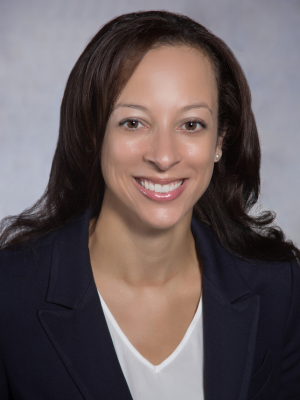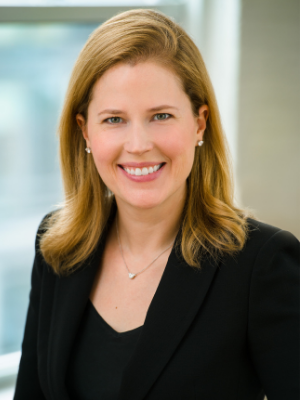 “I have a lot of passion for what I’m doing,” relates Vanessa McMichael, Head of Corporate & Public Entity (CPE) Strategy at Wells Fargo. “I want to make the most of each day that is in front of me.”
“I have a lot of passion for what I’m doing,” relates Vanessa McMichael, Head of Corporate & Public Entity (CPE) Strategy at Wells Fargo. “I want to make the most of each day that is in front of me.”
McMichael shares her insights on finding her niche in the financial industry, using her voice to elevate and empower others, and being a single mother while working towards her career goals.
Putting in the Work
Speaking to what she has learned so far in her career, McMichael maintains, “you have to put in the work. There’s no substitute for it. Any leader that you speak with has put in the work and is still putting in the work. It’s something that I harp on a lot, because it is necessary. It certainly has gotten me to where I am today.”
McMichael is the first person in her family to go to a traditional four-year college, and she recognizes her parents as giving her the grit and work ethic to succeed. Her father, an African American nuclear engineer and small business owner, emphasized to McMichael throughout her childhood, “Vanessa, you have to work hard. You’re going to have to work harder than other people.” It was an important life lesson that aided his own success, and one that he passed on to her.
Giving birth to Vanessa in high school, her mother did not get the chance to graduate and subsequently worked in factories her entire life. When her parents split up when she was young, she witnessed her mother work hard to rebuild her life, demonstrating to McMichael that, “if you want it, you have to go get it. No one else is going to just hand you what it is you think you need.” And, even more importantly, she saw firsthand how women can do it all.
Moreover, Vanessa is a childhood cancer survivor, and this is one of the central reasons why she strives to seize each day. This is also a reason why she has to be mindful about taking on too much, “because it’s easy to do when you’re trying to make the most of every day.” And although her parents taught her how to work hard through leading by example, her experience with cancer was a significant contributor to her drive and work ethic. She highlights that going through an experience like that suddenly, with no prior family history, and as a child, “changes your perspective and stays with you.”
McMichael took these experiences to heart, and it gave her the drive to reach goals she set for herself. After studying Japanese in high school, she attended Howard University’s business school. Initially, she wanted to move to Japan and create commercials, and she thought business school was a good starting point. But instead, she discovered her path to the banking/financial services industry after listening to a presentation by Wachovia on campus. She remembers being struck by the diverse representation of people at the presentation and compelled by the work they described.
After graduating and working for Wachovia for a few years, she then went on to get an MBA from one of the top business schools in the country, the University of Chicago Booth Business School. Following her MBA, she joined a rotational program at Wells Fargo on the trading floor where she had the opportunity to explore different areas of the business. It was during that program that she “stumbled” into the strategy group, an area she has been working in ever since.
Finding Her Niche
Working in the strategy group at Wells Fargo for over a decade, McMichael points to the value of finding your niche and a role that is a “good” fit. In particular, she highlights the variety of work she does day-to-day and the relationships that she has made as what keeps her role fresh and interesting.
“With our clients, who are corporations and public entities, my job is to equip them with what they need to make informed fixed income decisions. So, with that, my day-to-day is always different. I can talk to five retailers in one day, all in the same industry, but the conversations are varied.”
Vanessa added that although each client situation is unique, there has been a shift in the broader conversation with clients this year as the rate environment falls. “We are no longer in an environment where organizations can sit back and earn interest on excess cash so easily.”
Harkening back to her high school dream of creating commercials in Japan, she recognizes that her career at Wells Fargo is maybe not so far off from where she thought she would start: “I’m not creating commercials, but I am creating stories. I’m telling the story of what’s happening in fixed income markets and how the narrative can impact my clients.”
Another element of her job that she enjoys is having the opportunity to speak at conferences that corporate and public entity clients attend. She adds, “That’s probably what I enjoy the most about my job, is getting on stage. I’ve even told folks that I’m probably more comfortable getting on the stage in front of a lot of people than having a one-on-one.”
McMichael recently had the opportunity to speak to a much larger audience when she was interviewed on Bloomberg TV, addressing money market funds and the outlook for 2024. As this was her first live TV experience, she was initially nervous about being on camera, but then she found her rhythm, and it turned out to be a lot of fun.
Mentorship and Sponsorship
McMichael recognizes mentorship and sponsorship as contributing factors to getting her to where she is today, particularly as they not only helped her learn the “rules of the road,” but also “what I need to know” to succeed.
“I’ve had to build mentorship relationships to learn the rules of the road on the trading floor because the rules are not apparent all the time.” She adds that it is important to have both mentors and sponsors because, “sponsors are the folks who are telling me what I need to know and helping me take action to obtain it. I’m sharing projects that I’m working on or what I’m thinking, and they will say, okay, ‘you’re thinking this, you should go meet this person.’ That’s part of the role of a sponsor and the other part is speaking on your behalf when you’re not in the room.”
Using Her Voice
Reflecting on being a woman of color in the financial industry, McMichael believes that she is in control of how she is perceived, so it is important to use her voice to that effect.
“Going into situations, I’m very aware of who I am. I am a woman. I look different. I don’t think people automatically assume that I’m Black because I am mixed. So, I have a voice, and I use it. Instead of shying away or being self-conscious, I use it as an advantage. I want to be a good representative of women, of women of color, and of diverse women. We all have a voice, and we have to advocate for ourselves.”
McMichael takes action and uses her voice by supporting other women through the WomenGoFar network in Wells Fargo’s Corporate & Investment Banking division. While on the committee she created a speed networking event where women had the chance to meet five to ten new people within an hour. It was an impactful way for junior women to get a chance to meet women leaders, who might not otherwise have the time to commit to a longer networking activity during work hours. And likewise, the senior leaders appreciated interacting and hearing from junior women across business lines.
Taking her support for women in the workplace a step further, McMichael recently coordinated a wellness workshop on stress and the impact it can have on the body, particularly as women are often juggling many different demands on their time and energy. This topic is especially important to her given her health history. McMichael is thrilled this initial idea has developed into a Wellness Series and is looking forward to creating additional content to further promote the well-being of women.
In addition to taking action to elevate women, McMichael has a network of African American colleagues that she engages with regularly, whether through sharing job opportunities or articles of interest to keep the dialogue going. “We have Employee Resource Networks for diverse teammates, but this is a grassroots way that I’m trying to engage and educate particularly around internal mobility for our diverse talent.”
These projects demonstrate the value of creating a space for connection that supports the advancement and inclusion of a diverse workforce.
Being a Single Parent and Succeeding in a Career in Finance
Connecting with colleagues who can understand her experience was also an important part of McMichael’s journey, as there was a time that she balanced being a single mother and developing her career. McMichael remembers when she first became a mother, she met senior women around her with stay-at-home husbands, and so her confidence wavered as to whether she would be able to advance in her career without one. She worried that she would be “stuck,” because she did not have the same kind of support. But she met other single parents at Wells Fargo who could relate from a lifestyle perspective.
“That connection with people opened this new life for me. One where I went from feeling isolated and stuck to one where I felt empowered and supported.” She continues, “If I could speak to younger Vanessa, I would tell her not to feel that you can’t be successful in this business, because you’re a single parent.”
McMichael expresses her joy in motherhood and the exciting prospect of sharing her interests with her now older daughter. Recently, McMichael introduced her daughter to salsa dance, a passion she held before becoming a mom. They also enjoy traveling and exploring together. As she looks ahead, McMichael is energized to continue growing and challenging herself at work, while keeping up with her daughter and husband and their busy life at home.
By Jessica Robaire





 by Liz O’Donnell (Boston)
by Liz O’Donnell (Boston) by Pamela Weinsaft (New York City)
by Pamela Weinsaft (New York City)